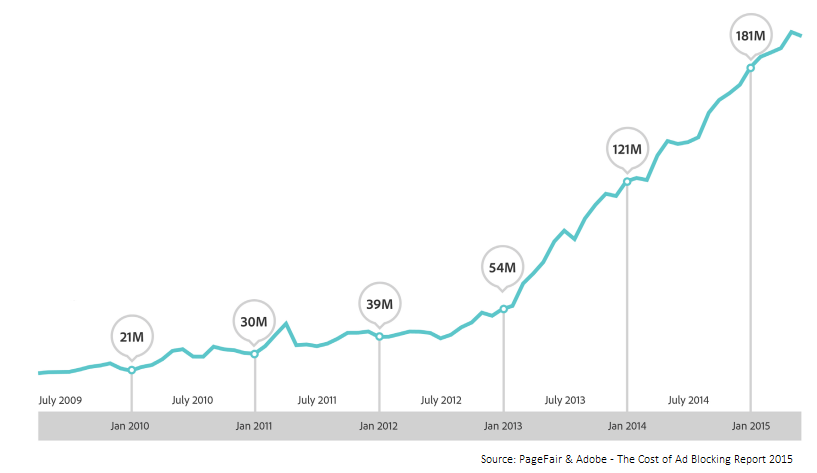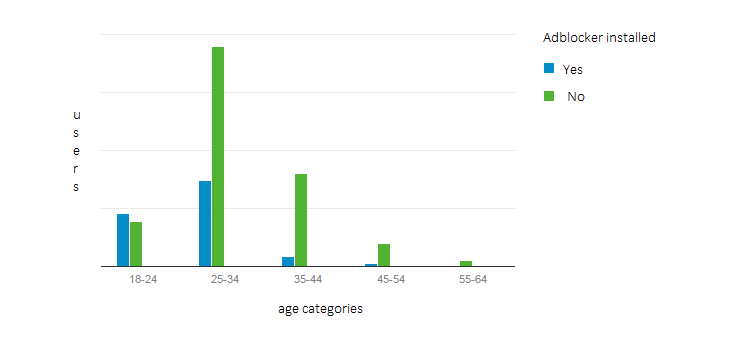The use of ad-blockers is growing fast, as consumers are getting tired of irrelevant and annoying advertisements. According to Adobe and PageFair, 181 million online consumers use an ad-blocker and 41,4 billion dollars of income is being missed out by online publishers due to the use of ad-blockers.

As these numbers are general, it is interesting to investigate if these numbers are applicable to all websites or dependent on the audience of your website. In order to gain insight into the number of visitors that uses an ad-blocker we have placed a piece of code on this blog and on another website (website X) with a totally different audience. This piece of code tracks if a visitor is using an ad-blocker or not and sends the results to Google Analytics which gives us a more detailed view of the visitors that use an ad-blocker.
As base for the code we used the post of Martijn Hoiting which explains how to track how many users are using ad-block software trough Google Analytics with some help from Google Tag Manager. The code creates a fake ad at the bottom of the webpage and the javascript code checks if the div is loaded or not. My colleague Erik Driessen re-wrote the code and removed the jQuery part. Also he added display: none; to the script in order to make sure the bottomAd div won’t be visible on the website.
HTML element to mimic the behaviour of an ad
<div id="bottomAd" style="font-size: 2px;"> </div>
This div element is the one that Google AdSense uses to serve ads. If you have AdSense running on your page, don’t place this tag.
JavaScript to track ad-blocking
var getAdElement = document.getElementById('bottomAd');
if(getAdElement.clientHeight === 0){
//track ad-blocker enabled
}else{
//track ad-blocker disabled
}
getAdElement.style.display = "none";
The JavaScript snippet that detects if an ad-blocker is enabled.
The downside of this code is that it does not work when visitors are also blocking Google Tag Manager or Google Analytics. In order to track these visitors you can also use this script that works with a PHP-file. As you need to place the script hard-coded on every page you want to track, you need access to the webserver which can make it less flexible than implementing our script trough GTM.
The usage of ad-blockers
When looking at the percentage of visitors that uses an ad-blocker, the first difference shows between the two websites. Almost a third of the visitors of The Marketing Technologist (TMT) uses an ad-blocker which is a lot compared to website X where only 5 percent of the visitors uses an ad-blocker. When looking at the usage of ad-blockers in combination with visits from a desktop the percentage increases with around 10 percent at TMT and with 5 percent on website X. The usage of Ad-blockers on mobile devices as tablets and smartphones is negligible.

Visitors with ad-blocker from desktop
Operating System and browser
As shown in the previous chapter the usage of ad-blockers may vary a lot between different websites. The next question is, do the various operating systems show different usage of ad-blockers? The answer is no. Visitors that use Windows, Mac OS X or Linux practically show the same percentage of ad-blocker users.

Visitors with ad-blocker per browser
The three most used browsers: Chrome, Firefox and Internet Explorer show big differences in ad-blocker usage based on the visitors of TMT. All the visitors using Internet Explorer didn’t use an ad-blocker at all. The simplicity of installing plug-ins in Chrome and Firefox result in a high rate of ad-blocker users in the other two browsers: 37% and 42%.
Demographics
Assuming that the type of audience of your website influences the usage of ad-blockers, it might be interesting to know something about the demographic aspects of ad-blocker users. The first demographic aspect is gender. Ad-blockers are mostly used by male visitors on both websites. At website X the percentage of male ad-blocker users doubles the percentage of female ad-blocker users.
When looking at the age of ad-blocker users it shows that ad-blockers are most popular with the age categories: 18-24 and 25-34 (based on data from TMT). Users older then 34 doesn’t seem to be interested in using an ad-blocker or they might don’t know how to install them.

Conclusion
All things considered, it seems that the percentage of visitors using an ad-blocker is dependent on the audience of your website. The assumption is that more and more consumers will start using an ad-blocker in the future and blocking ads will become the standard.
It is our intention that in the coming weeks, the script will run on the websites of multiple clients in order to get a better picture of the percentage ad-block users.







Leave a Reply
You must be logged in to post a comment.